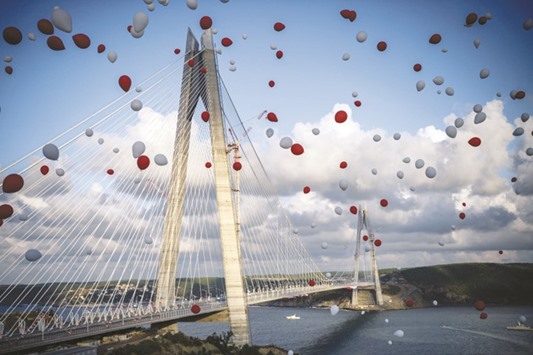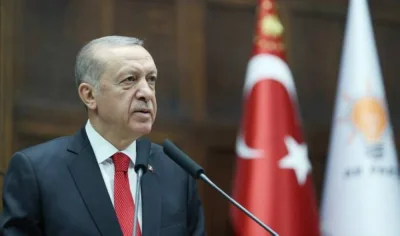Turkey opened one of the world’s biggest suspension bridges yesterday, the latest megaproject in a $200bn building spree that President Tayyip Erdogan hopes will secure his place in history.
The bridge creates a new link across the Bosphorus Strait, which divides Asia and Europe. It is built in the style of New York’s Brooklyn Bridge and boasts pylons higher than the Eiffel Tower. It is 1.4 km long and 59m wide, with eight vehicle lanes and two high-speed rail lines.
“When man dies, he leaves behind a monument,” Erdogan told a crowd of thousands waving Turkish flags at the opening ceremony on the shores of the Bosphorus next to the bridge.
“Be proud of your power, Turkey,” said a TV advert before the opening of the $3bn Yavuz Sultan Selim Bridge on the edge of Istanbul. It is named after a 16th-century Ottoman ruler.
Erdogan’s infrastructure drive is transforming Europe’s biggest city, which straddles the Bosphorus Strait. In a little more than a decade, Istanbul’s skyline has soared, new highways have been built and the length of the metro tripled.
The Yavuz Sultan Selim, which runs from the Garipce area on Istanbul’s European side to the region of Poyrazkoy on the Asian side, is the third bridge to span the Bosphorus Strait and can withstand winds of 300km an hour. It ranks among the world’s biggest suspension bridges, in terms of width of deck, height of pylons as well as length of span.
It has been built by Italy’s Astaldi and Istanbul-based IC Ictas which will jointly operate it for about a decade.
Officials say the bridge will ease congestion in a city of 14mn people, reduce fuel costs and save workers time.
Turkey closed deals to secure $45bn in private infrastructure investment last year, absorbing 40% of the global total, according to the World Bank.
Other planned megaprojects include the world’s biggest airport in Istanbul and a huge canal that would render a large chunk of the city an island.
Such undertakings trumpet Turkey’s regional clout and drive the economy, Transport Minister Ahmet Arslan told Reuters near the bridge site at Garipce. Construction accounts for 6% of output and employs 2mn people.
“Turkey, by virtue of its geography, bridges Asia and Europe, the Balkans and the Caucasus, but to benefit from this position, we need arteries and corridors,” he told Reuters. “There is money to be made by easing transportation between Europe and Asia, and this is why we are doing these projects.”
As Arslan spoke, workers scaled the bridge’s gleaming white steel cables. Some 300 metres below, crude tankers rumbled north through the Bosphorus, one of the world’s busiest oil transit points, connecting the Black Sea and the Mediterranean.
Each day, 650 new cars hit Istanbul’s roads, Arslan said, making it the word’s third-most congested city and increasing travel times by 50%, according to TomTom Traffic Index.
The bridge “is a symbol and much like Turkey a gateway”, said Paolo Astaldi, chairman of Astaldi which owns a third of the joint venture. “It not only alleviates traffic in Istanbul, it speeds movement of goods across Turkey and, as Syria stabilises, the importance of the link will increase.”

Red and white air-balloons flying in the sky next to the Yavuz Sultan Selim bridge in Istanbul during its inauguration. The bridge u2013 technically a hybrid between a suspension and cable-stayed bridge u2013 is an architectural marvel spanning the steep banks of the Bosphorus at the entrance to the Black Sea.


